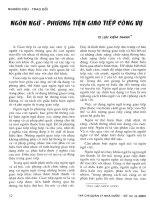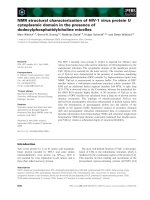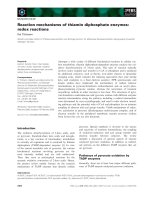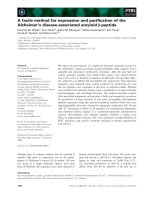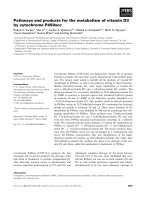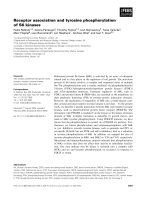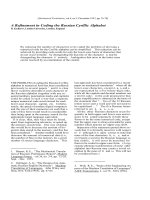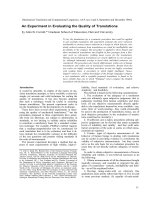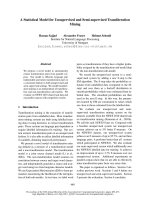Tài liệu Báo cáo khoa học: "Using Structural Information for Identifying Similar Chinese Characters" pdf
Bạn đang xem bản rút gọn của tài liệu. Xem và tải ngay bản đầy đủ của tài liệu tại đây (113.68 KB, 4 trang )
Proceedings of ACL-08: HLT, Short Papers (Companion Volume), pages 93–96,
Columbus, Ohio, USA, June 2008.
c
2008 Association for Computational Linguistics
Using Structural Information for Identifying Similar Chinese Characters
Chao-Lin Liu Jen-Hsiang Lin
Department of Computer Science, National Chengchi University, Taipei 11605, Taiwan
{chaolin, g9429}@cs.nccu.edu.tw
Abstract
Chinese characters that are similar in their
pronunciations or in their internal structures
are useful for computer-assisted language
learning and for psycholinguistic studies. Al-
though it is possible for us to employ image-
based methods to identify visually similar
characters, the resulting computational costs
can be very high. We propose methods for
identifying visually similar Chinese characters
by adopting and extending the basic concepts
of a proven Chinese input method Cangjie.
We present the methods, illustrate how they
work, and discuss their weakness in this paper.
1 Introduction
A Chinese sentence consists of a sequence of char-
acters that are not separated by spaces. The func-
tion of a Chinese character is not exactly the same
as the function of an English word. Normally, two
or more Chinese characters form a Chinese word to
carry a meaning, although there are Chinese words
that contain only one Chinese character. For in-
stance, a translation for “conference” is “研討會”
and a translation for “go” is “去”. Here “研討會”
is a word formed by three characters, and “去” is a
word with only one character.
Just like that there are English words that are
spelled similarly, there are Chinese characters that
are pronounced or written alike. For instance, in
English, the sentence “John plays an important roll
in this event.” contains an incorrect word. We
should replace “roll” with “role”. In Chinese, the
sentence “今天上午我們來試場買菜” contains an
incorrect word. We should replace “試場” (a place
for taking examinations) with “市場” (a market).
These two words have the same pronunciation,
shi(4) chang(3)
†
, and both represent locations. The
sentence “經理要我構買一部計算機” also con-
†
We use Arabic digits to denote the four tones in Mandarin.
tains an error, and we need to replace “構買” with
“購買”. “構買” is considered an incorrect word,
but can be confused with “購買” because the first
characters in these words look similar.
Characters that are similar in their appear-
ances or in their pronunciations are useful for
computer-assisted language learning (cf. Burstein
& Leacock, 2005). When preparing test items for
testing students’ knowledge about correct words in
a computer-assisted environment, a teacher pro-
vides a sentence which contains the character that
will be replaced by an incorrect character. The
teacher needs to specify the answer character, and
the software will provide two types of incorrect
characters which the teachers will use as distracters
in the test items. The first type includes characters
that look similar to the answer character, and the
second includes characters that have the same or
similar pronunciations with the answer character.
Similar characters are also useful for studies
in Psycholinguistics. Yeh and Li (2002) studied
how similar characters influenced the judgments
made by skilled readers of Chinese. Taft, Zhu, and
Peng (1999) investigated the effects of positions of
radicals on subjects’ lexical decisions and naming
responses. Computer programs that can automati-
cally provide similar characters are thus potentially
helpful for designing related experiments.
2 Identifying Similar Characters with In-
formation about the Internal Structures
We present some similar Chinese characters in the
first subsection, illustrate how we encode Chinese
characters in the second subsection, elaborate how
we improve the current encoding method to facili-
tate the identification of similar characters in the
third subsection, and discuss the weakness of our
current approach in the last subsection.
2.1 Examples of Similar Chinese Characters
We show three categories of confusing Chinese
characters in Figures 1, 2, and 3. Groups of similar
93
characters are separated by spaces in these figures.
In Figure 1, characters in each group differ at the
stroke level. Similar characters in every group in
the first row in Figure 2 share a common part, but
the shared part is not the radical of these characters.
Similar characters in every group in the second
row in Figure 2 share a common part, which is the
radical of these characters. Similar characters in
every group in Figure 2 have different pronuncia-
tions. We show six groups of homophones that
also share a component in Figure 3. Characters that
are similar in both pronunciations and internal
structures are most confusing to new learners.
It is not difficult to list all of those characters
that have the same or similar pronunciations, e.g.,
“試場” and “市場”, if we have a machine readable
lexicon that provides information about pronuncia-
tions of characters and when we ignore special pat-
terns for tone sandhi in Chinese (Chen, 2000).
In contrast, it is relatively difficult to find
characters that are written in similar ways, e.g.,
“構” with “購”, in an efficient way. It is intriguing
to resort to image processing methods to find such
structurally similar words, but the computational
costs can be very high, considering that there can
be tens of thousands of Chinese characters. There
are more than 22000 different characters in large
corpus of Chinese documents (Juang et al., 2005),
so directly computing the similarity between im-
ages of these characters demands a lot of computa-
tion. There can be more than 4.9 billion
combinations of character pairs. The Ministry of
Education in Taiwan suggests that about 5000
characters are needed for ordinary usage. In this
case, there are about 25 million pairs.
The quantity of combinations is just one of
the bottlenecks. We may have to shift the positions
of the characters “appropriately” to find the com-
mon part of a character pair. The appropriateness
for shifting characters is not easy to define, making
the image-based method less directly useful; for
instance, the common part of the characters in the
right group in the second row in Figure 3 appears
in different places in the characters.
Lexicographers employ radicals of Chinese
characters to organize Chinese characters into sec-
tions in dictionaries. Hence, the information should
be useful. The groups in the second row in Figure
2 show some examples. The shared components in
these groups are radicals of the characters, so we
can find the characters of the same group in the
same section in a Chinese dictionary. However,
information about radicals as they are defined by
the lexicographers is not sufficient. The groups of
characters shown in the first row in Figure 2 have
shared components. Nevertheless, the shared com-
ponents are not considered as radicals, so the char-
acters, e.g., “頸”and “勁”, are listed in different
sections in the dictionary.
2.2 Encoding the Chinese Characters
The Cangjie
‡
method is one of the most popular
methods for people to enter Chinese into com-
puters. The designer of the Cangjie method, Mr.
Bong-Foo Chu, selected a set of 24 basic elements
in Chinese characters, and proposed a set of rules
to decompose Chinese characters into elements
that belong to this set of building blocks (Chu,
2008). Hence, it is possible to define the similarity
between two Chinese characters based on the simi-
larity between their Cangjie codes.
Table 1, not counting the first row, has three
‡
士土工干千 戌戍成 田由甲申
母毋 勿匆 人入 未末 采釆 凹凸
Figure 1. Some similar Chinese characters
頸勁 搆溝 陪倍 硯現 裸棵 搞篙
列刑 盆盎盂盅 因困囚 間閒閃開
Figure 2. Some similar Chinese characters that have
different pronunciations
形刑型 踵種腫 購構搆 紀記計
園圓員 脛逕徑痙勁
Fi
g
ure 3. Homo
p
hones with a shared com
p
onen
t
Cangjie Codes Cangjie Codes
士 十一 土 土
工 一中一 干 一十
勿 心竹竹 匆 竹田心
未 十木 末 木十
頸 一一一月金 勁 一一大尸
硯 一口月山山 現 一土月山山
搞 手卜口月 篙 竹卜口月
列 一弓中弓 刑 一廿中弓
因 田大 困 田木
間 日弓日 閒 日弓月
踵 口一竹十土 種 竹木竹十土
腫 月竹十土 紀 女火尸山
購 月金廿廿月 構 木廿廿月
記 卜口尸山 計 卜口十
圓 田口月金 員 口月山金
脛 月一女一 逕 卜一女一
徑 竹人一女一 痙 大一女一
Table 1. Cangjie codes for some characters
94
sections, each showing the Cangjie codes for some
characters in Figures 1, 2, and 3. Every Chinese
character is decomposed into an ordered sequence
of elements. (We will find that a subsequence of
these elements comes from a major component of a
character, shortly.) Evidently, computing the num-
ber of shared elements provides a viable way to
determine “visually similar” characters for charac-
ters that appeared in Figure 2 and Figure 3. For
instance, we can tell that “搞” and “篙” are similar
because their Cangjie codes share “卜口月”, which
in fact represent “高”.
Unfortunately, the Cangjie codes do not ap-
pear to be as helpful for identifying the similarities
between characters that differ subtly at the stroke
level, e.g., “士土工干” and other characters listed
in Figure 1. There are special rules for decompos-
ing these relatively basic characters in the Cangjie
method, and these special encodings make the re-
sulting codes less useful for our tasks.
The Cangjie codes for characters that contain
multiple components were intentionally simplified
to allow users to input Chinese characters more
efficiently. The longest Cangjie code for any Chi-
nese character contains no more than five elements.
In the Cangjie codes for “脛” and “徑”, we see “一
女一” for the component “巠”, but this component
is represented only by “一一” in the Cangjie codes
for “頸” and “勁”. The simplification makes it
relatively harder to identify visually similar charac-
ters by comparing the actual Cangjie codes.
2.3 Engineering the Original Cangjie Codes
Although useful for the sake of designing input
method, the simplification of Cangjie codes causes
difficulties when we use the codes to find similar
characters. Hence, we choose to use the complete
codes for the components in our database. For in-
stance, in our database, the codes for “巠”, “脛”,
“徑”, “頸”, and “勁” are, respectively, “一女女一”,
“月一女女一”, “竹人一女女一”, “一女女一一月
山金”, and “一女女一大尸”.
The knowledge about the graphical structures
of the Chinese characters (cf. Juang et al., 2005;
Lee, 2008) can be instrumental as well. Consider
the examples in Figure 2. Some characters can be
decomposed vertically; e.g., “盅” can be split into
two smaller components, i.e., “中” and “皿”. Some
characters can be decomposed horizontally; e.g.,
“現” is consisted of “王” and “見”. Some have
enclosing components; e.g., “人” is enclosed in
“囗” in “囚”. Hence, we can consider the locations
of the components as well as the number of shared
components in determining the similarity between
characters.
Figure 4 illustrates possible layouts of the
components in Chinese characters that were
adopted by the Cangjie method (cf. Lee, 2008). A
sample character is placed below each of these
layouts. A box in a layout indicates a component in
a character, and there can be at most three compo-
nents in a character. We use digits to indicate the
ordering the components. Notice that, in the sec-
ond row, there are two boxes in the second to the
rightmost layout. A larger box contains a smaller
one. There are three boxes in the rightmost layout,
and two smaller boxes are inside the outer box.
Due to space limits, we do not show “1” for this
outer box.
After recovering the simplified Cangjie code
for a character, we can associate the character with
a tag that indicates the overall layout of its compo-
nents, and separate the code sequence of the char-
acter according to the layout of its components.
Hence, the information about a character includes
the tag for its layout and between one to three se-
quences of code elements. Table 2 shows the anno-
承郁 謝昭
君森葦 國因
1 1 2
12
3
1
23
3
2
1
1
2
3
2
2
1
1
2
3
Figure 4. Arrangements of components in Chinese
Layout Part 1 Part 2 Part 3
承 1 弓弓手人
郁 2 大月 弓中
昭 3 日 尸竹 口
謝 4 卜一一口 竹難竹 木戈
君 5 尸大 口
森 6 木 木 木
葦 7 廿 木一 手
因 8 田 大
國 9 田 戈 口一
頸 2 一女女一 一月山金
徑 2 竹人 一女女一
員 5 口 月山金
圓 9 田 口 月山金
相 2 木 月山
想 5 木月山 心
箱 6 竹 木 月山
Table 2. Annota
t
ed and ex
p
anded code
95
tated and expanded codes of the sample characters
in Figure 4 and the codes for some characters that
we will discuss. The layouts are numbered from
left to right and from top to bottom in Figure 4.
Elements that do not belong to the original Canjie
codes of the characters are shown in smaller font.
Recovering the elements that were dropped
out by the Cangjie method and organizing the sub-
sequences of elements into parts facilitate the iden-
tification of similar characters. It is now easier to
find that the character (頸) that is represented by
“一女女一” and “一月山金” looks similar to the
character (徑) that is represented by “竹人” and
“一女女一” in our database than using their origi-
nal Cangjie codes in Table 1. Checking the codes
for “員” and “圓” in Table 1 and Table 2 will offer
an additional support for our design decisions.
In the worst case, we have to compare nine
pairs of code sequences for two characters that
both have three components. Since we do not sim-
plify codes for components and all components
have no more than five elements, conducting the
comparisons operations are simple.
2.4 Drawbacks of Using the Cangjie Codes
Using the Cangjie codes as the basis for comparing
the similarity between characters introduces some
potential problems.
It appears that the Cangjie codes for some
characters, particular those simple ones, were not
assigned without ambiguous principles. Relying on
Cangjie codes to compute the similarity between
such characters can be difficult. For instance, “分”
uses the fifth layout, but “兌” uses the first layout
in Figure 4. The first section in Table 1 shows the
Cangjie codes for some character pairs that are dif-
ficult to compare.
Due to the design of the Cangjie codes, there
can be at most one component at the left hand side
and at most one component at the top in the layouts.
The last three entries in Table 2 provide an exam-
ple for these constraints. As a standalone character,
“相” uses the second layout. Like the standalone
“相”, the “相” in “箱” was divided into two parts.
However, in “想”, “相” is treated as an individual
component because it is on top of “想”. Similar
problems may occur elsewhere, e.g., “森焚” and
“恩因”. There are also some exceptional cases; e.g.,
“品” uses the sixth layout, but “闆” uses the fifth
layout.
3 Concluding Remarks
We adopt the Cangjie alphabet to encode Chinese
characters, but choose not to simplify the code se-
quences, and annotate the characters with the lay-
out information of their components. The resulting
method is not perfect, but allows us to find visually
similar characters more efficient than employing
the image-based methods.
Trying to find conceptually similar but con-
textually inappropriate characters should be a natu-
ral step after being able to find characters that have
similar pronunciations and that are visually similar.
Acknowledgments
Work reported in this paper was supported in part
by the plan NSC-95-2221-E-004-013-MY2 from
the National Science Council and in part by the
plan ATU-NCCU-96H061 from the Ministry of
Education of Taiwan.
References
Jill Burstein and Claudia Leacock. editors. 2005. Pro-
ceedings of the Second Workshop on Building Educa-
tional Applications Using NLP, ACL.
Matthew Y. Chen. 2000. Tone Sandhi: Patterns across
Chinese Dialects. (Cambridge. Studies in Linguistics
92.) Cambridge: Cambridge University Press.
Bong-Foo Chu. 2008. Handbook of the Fifth Generation
of the Cangjie Input Method, web version, available
at
Last visited on 14 Mar. 2008.
Hsiang Lee. 2008. Cangjie Input Methods in 30 Days,
Foruto
Company, Hong Kong. Last visited on 14 Mar. 2008.
Derming Juang, Jenq-Haur Wang, Chen-Yu Lai, Ching-
Chun Hsieh, Lee-Feng Chien, and Jan-Ming Ho.
2005. Resolving the unencoded character problem for
Chinese digital libraries. Proceedings of the Fifth
ACM/IEEE Joint Conference on Digital Libraries,
311–319.
Marcus Taft, Xiaoping Zhu, and Danling Peng. 1999.
Positional specificity of radicals in Chinese character
recognition, Journal of Memory and Language, 40,
498–519.
Su-Ling Yeh and Jing-Ling Li. 2002. Role of structure
and component in judgments of visual similarity of
Chinese characters, Journal of Experimental Psy-
chology: Human Perception and Performance, 28(4),
933–947.
96
